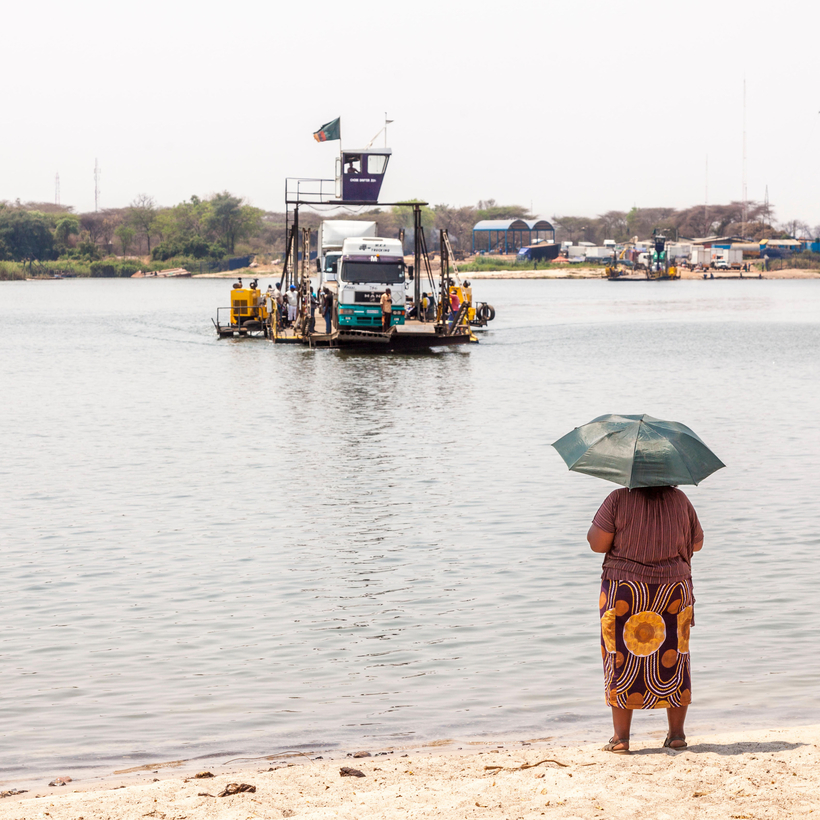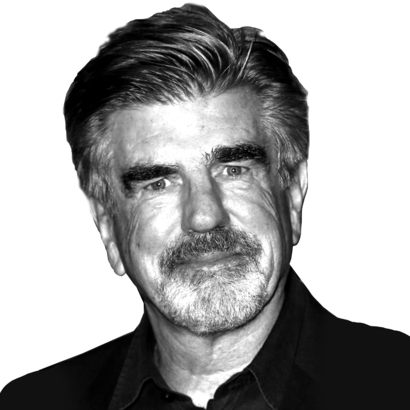With its crocodiles, hippos, and cobras, the Zambezi River in Southern Africa makes for a secure border. Swimming is verboten, and there are few bridges to cross. What you need is a boat. And, if you hop on one headed east toward Mozambique, at a narrow stretch you’ll come across a remote spot called “the Four Corners of Africa.” There are no signs declaring that this is “the World’s Only International Quadripoint,” but that’s what it is. It’s here that Botswana, Namibia, Zambia, and Zimbabwe all touch each other in a small single spot, the remnant of some long-ago colonial wheeling and dealing.
Convoys of Trucks
Kazungula is a small, dusty shantytown on the Zambia side. It is the main commercial hub for crossing in any direction by ferry. I drove there one day in April from Livingstone under a blazing sun, cutting straight through a national park dotted with clusters of small, brownish huts cut out from the surrounding bush. Almost everyone in Kazungula is a transient. The town sits right on one of the main Trans-African Highway corridors. Convoys of trucks loaded with copper and other commodities from Zambia’s Copperbelt pass through here and come against the river. As there are only a couple of two-trucks-at-a-time pontoon ferries, drivers can wait two to three weeks to cross. This makes for a whole city of single guys with nothing to do 24-7. It’s a permanent spring break on the Zambezi.
Not everything in Kazungula is in transit. One thing not going away is the H.I.V./AIDS virus. It thrives here. Like the bathhouses of 70s San Francisco, Kazungula is an H.I.V. amplifier, sending new infections out in all directions every day. Places like this are holdouts, hard to reach AIDS hot spots in a battle being waged smartly elsewhere. To arrive in Kazungula is to arrive at the bottom of the pandemic barrel. Some people today would have you think that the AIDS crisis has passed. After almost 40 years, media interest is down and people are de-sensitized. There are even ads on TV for drugs to prevent you from catching it. The United States’ H.I.V. infection rate is only 0.3 percent of the population. That sort of good news can make us forget that there is no cure in sight and that AIDS in Africa has been at biblical levels of destruction.
It’s a permanent spring break on the Zambezi.
Besides this common border, the Four Corner countries share one of the world’s most dreadful records. They comprise four of the top seven countries with the highest H.I.V. infection rates. Botswana has a 22 percent H.I.V. infection rate. Where I was, in Zambia, it’s about 12 percent. Think for a minute about what life in the U.S. would be like if 72 million people had H.I.V./AIDS instead of the current 1.2 million. Nothing else would matter.
Border towns, generally not for the lighthearted, can be especially lethal in Africa. They are primary vectors for the virus. Europeans carved up Africa long ago into 54 countries, many tiny. The continent is chock-full of borders. Many border towns brim with touts, thieves, smugglers, bars, truck drivers, various people on the take, and, most of all, sex workers. In these sex free-fire zones, the H.I.V./AIDS rate can be more than 50 percent for both the sex workers and the truck drivers who use them.
Approaching Kazungula from the north, many miles out of town, large trucks begin appearing on both sides of the highway. Soon they are bumper to bumper, like two stalled freight trains. This goes on for miles, hundreds and hundreds of huge trucks. They pile up near the river in jammed lots that are fenced off. It’s jaw-dropping, all this wasted time. Sitting around the trucks are “moto boys,” young urchins who care for the vehicles. They wash the tires and watch the goods as the drivers head off to Club Z, the M&M Entertainment Center, or any number of other saloons and brothels. Women fruit sellers, with baskets on their heads and babies in a sling, along with prostitutes in full-on prostitute regalia, roam about in the sun, winding their way around potholes, rapping on truck-cab doors. Kiosks advertise phone charging. There is a cinder-block building for showering. Sex workers from several countries have flocked there to ply their trade in brothels, private apartments, and even by going truck to truck. A full economy has sprung up around the lines of these parked trucks.
As for the truckers, they are the rock stars of Africa. Kids want to grow up and be a macho Lothario dude, rolling country to country in a big-ass rig with pockets full of cash, time on their hands, girls aplenty, and a family so far away that, as one trucker told me, maybe you see them two to four days a month. Truckers are red-blooded guys with H.I.V. in their veins.
Sex workers from several countries have flocked there to ply their trade in brothels, private apartments, and even by going truck to truck.
I traveled to Kazungula with a delegation of partners of (RED), an organization that works with companies making products such as the (RED) iPhones. A portion of the profits go to support the Global Fund, an organization that fights AIDS, malaria, and TB. (RED) has raised almost $700 million for the Global Fund, and $60 million of that has been spent in Zambia, keeping almost 100,000 people there alive. (RED) is part of the ONE Campaign, an advocacy group that fights extreme poverty. (I am board chair.) We were there to get a sense of where that money goes and how the pandemic is being fought.

Anti-retroviral therapy (ART) has revolutionized treatment and saved the day worldwide with H.I.V./AIDS, beginning slowly back in the early 1980s. One or two of these pills daily suppress the virus, let one lead a normal life, and lower the risk of passing the virus to others. Right now, 15 million people are walking the earth in Africa who would have been dead without these drugs. America and the Global Fund have led and paid for much of this battle. By far, it’s the biggest, most successful health intervention in the history of the world. Good news few know.
As for the truckers, they are the rock stars of Africa.
Before these drugs, AIDS had ravaged these countries. There was virtually no health infrastructure to deal with it. Most victims were women. Even if you didn’t have AIDS, your community was likely in a death spiral. Economies were tanking, people were dying left and right, and orphans were everywhere. About the only growth business was making coffins. With the widespread adoption of ART, things began to bounce back. People rose like Lazarus. Zambia has continued to make a lot of progress in halting and reversing the epidemic. New infections are down, 75 percent of people with H.I.V. now receive free ART, fewer people are dying, and there is a new emphasis on the high-risk populations. Still, in certain groups, like young girls, the infection rates are skyrocketing. A thousand girls a day get H.I.V. worldwide, most in Africa.
Get Out Before Dark
We went to see the brand-new “border clinic” in Kazungula. It was set in a small shipping container with a spotless small office, covered with posters, and an adjoining examination room. The container was parked under a large mango tree next to shop stalls, where people were going over used clothing that sat in piles in the dirt. Young prostitutes sat quietly, smiling, waiting to be tested. Two very pleasant uniformed nurses did the testing, gave out information, and distributed free condoms. Business seemed brisk but not overwhelming.
A woman from the local health ministry sat us down under the mango tree and gave us a presentation. Two truck drivers, curious, came over to join us. They loved the trucking life, they said. Sex here cost five dollars for a “short time,” they had regular girls and “used condoms and pills,” their families were far away, and, by the way, if we thought Kazungula was bad, there was now a 17-kilometer backup at the Congolese border. All the while, prostitutes kept strolling around us. The lady from the ministry, not a fan, called them “vermin.” When I asked what it was like at night, she just shook her head and said, “Wild.” They close at six and get the hell out.
A Bridge to Somewhere
But hope looms in Kazungula. A big, new, 3,000-foot bridge across the Zambezi to Botswana is half built and will be completed next year. Japan and the African Development Bank have financed this $260 million project. It has two lanes and room for a railroad, when the railroad comes to town. The reason for optimism is obvious. If the truck convoys can just roll through, instead of remaining bottlenecked for weeks, business will grow and there should be fewer infection points.
There is so much talk these days about border walls. Kazungula reminds us that the future may depend more on bridges.
Tom Freston is a media-and-entertainment executive and the board chair of the ONE Campaign, an anti-poverty organization


